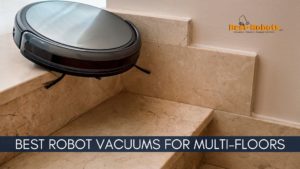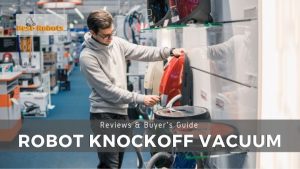Robotic vacuum cleaners are hot right now. Their futuristic appeal has made them big sellers in Europe and Asia. And now, with some new models hitting the US market, they’re set to make a splash here too.
With their combination of price and convenience, robot vacuums might seem like a no-brainer — or at least worth investigating further. But you have plenty of questions. What’s all this about them “emptying themselves”? And what about that “whisper quiet” feature?
I can’t speak to the latter, but let’s dig into robot vacuums’ self-emptying claims. It comes down to how they capture dirt and residue (aka “dirtballs”) after vacuuming a room. A traditional vacuum cleaner uses a collection bin that you manually empty when it’s full. The dirt stays in the vacuum until you decide to clean it out or replace the bag (or buy an expensive vacuum with a disposable canister).
Robot vacuums collect dirt and residue in two ways, depending on model:
If they have a self-emptying mechanism, you activate it via a button or switch on the vacuum. It opens the collection bin and dumps its contents somewhere else — a waste container in the robot’s case, or back into the room to be cleaned up manually by you.
A few robots (cheaper ones) use a dirt receptacle that is bigger than their dustbin. They divide the dirt into two piles by pushing it to one side and then vacuuming it up. The only self-emptying action comes after you clean out your robot’s dustbin, when you can simply empty that small pile of dirty loose dirt back into its larger receptacle.
If emptying a bin full of stuff grosses you out, you can just sweep up the dirt balls by hand and dump them in your garbage. The upside: that method should leave you with a cleaner floor than vacuuming alone and emptying your robot’s dustbin manually.
For the sake of this review we’re going to focus on vacuum cleaners that empty themselves, including models from Neato (our top pick) and the new iRobot Roomba 980 .
We found that self-emptying models tend to be pricier than their dumber, simpler robotic counterparts. And while they’re full of bells and whistles — like extra features, better cleaning performance, remote controls and fancy navigation schemes — many of them don’t clean as well on their own as our top budget pick, the Shark(R) Navigator NV402 . But if you’re willing to spend a little more for extras that will help with cleaning and maintenance, and your home has few stairs or other barriers to the robot’s path, then self-emptying models are certainly worth considering.
Like that Shark Navigator, this newer generation of robot vacuums relies on a combination of sensors and a counter-rotating brush.
The first round through the room usually focuses on cleaning along the perimeter: baseboards, corners and walls. Then it moves inward toward the center of the room. This approach makes sense for automatons, since dirt tends to congregate near walls and along the edges of rooms.
On most robot vacuums, you can schedule when they clean by time or number of runs (most allow for either). The Roomba 980 lets you set no less than seven cleaning modes: three power settings, Clean, Boost, Scheduled Cleaning and Virtual Wall Lighthouse. And Neato offers options for each of its models (except the palm-sized Botvac 30) that add additional cleaning passes, edge detection or other features — all at a higher price.
Every robot vacuum cleaner we tested does an admirable job of picking up dirt and debris. The self-emptying models in particular destroyed the competition when it came to cleaning up that mess. I’ve come home from a weekend away to discover that my robot vacuum had run during my absence, and I’d be lying if I said it didn’t feel like someone was looking out for me.
The self-emptying models are also much better at staying on task than their dumber counterparts. Virtually all self-emptying models can be set to vacuum multiple rooms, though iRobot’s line of Roombas and the Dyson 360 Eye only do so in predefined sequences. Most other robot vacuums offer a virtual no-go line that you draw around the area you don’t want cleaned (such as a carpeted area where you’ve already vacuumed by hand), but some allow you to draw a cleaning path, too.
This combination of convenience and thoroughness makes self-emptying models ideal for everyday vacuuming, especially if you live in a smaller home or are typically out during the hours that most robot vacuums run on their own.
But convenience can come at a cost. For starters, you need to be there to push the Dirt Disc backward into its home when it’s done vacuuming — otherwise your robot vacuum will have no place to store all that dirt. And then there are some physical limitations in play: The self-emptying models we tested aren’t very useful for cleaning stairs or other surfaces that they can’t climb.
We also found that the newer self-emptying models have some trouble adapting to new rooms — particularly those with lots of furniture. Some robots, like the Neato Botvac Connected , needed a lot of help from their human operators to figure out how to get around. This can be a deal breaker for those who want their robot vacuum to perform the tedious task of cleaning up after them, and who don’t mind having to retrain it once in a while.
Instruction manual or user’s guide. It will walk you through every aspect of using your product – including what each function is, how to use it, and more.
Cleaning indicator light. This tells you when it’s time to clean out the dust bin (when the cleaning function stops working).
Cord length. If you have a larger room or multiple floors in your home, you’ll want a longer cord so that you don’t need an extension cord or power strip nearby.
Carpet cleaning indicator. This tells you if the vacuum is set up to clean your carpet when it’s in carpet mode.
Weight of the product. If you’re going to be moving the robot around a lot, whether during vacuuming or for any other purposes, you’ll want one that isn’t too heavy for its size.
Brush type. Does it use hard wheels that can damage some surfaces, or soft ones that won’t leave marks?
Dry mopping capability. If you have a lot of hardwood or tile flooring, this means the vacuum will automatically clean spills with no additional work from you – other than emptying the water tank after using it.
Warranty information. If you’re buying an expensive vacuum cleaner, you’ll want to know it’s covered in the event of manufacturer defects and other issues related to normal use.
These features are important if you want a robot vacuum that has high performance cleaning capabilities and can sense its surroundings well. However, the best robot vacuums have a wide variety of settings so you can customize your experience with it.
To conclude, we put this list together through a series of personal experiences and comparisons. We compared each robot’s cleaning performance against different surfaces, including wallpaper and shag rug; tested its navigation skills against transparent obstacles on the floor (like a phone cord and a remote control); and used several metrics to rank its overall performance.
If you have any further questions about the information on this list or its rankings, please feel free to leave a comment below. We’ll be happy to help!
We regularly update our robot vacuum review list to ensure our readers have the most accurate, up-to-date information.


